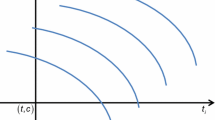Abstract
Models of individual choice behavior have been extensively developed and used in travel prediction during the last ten years. These models are generally formulated with utility functions that are linear in parameters. Theories of economics and psychology suggest that the true relationship between service variables and utility is non-linear. In this paper we demonstrate that non-linear transformations of time and cost variables produce statistically significant improvements in the model estimated, have a theoretically appealing interpretation, and lead to managerially important differences in policy evaluations. These results support the need to refine the specification of choice utility functions based on theoretical considerations and empirical research.
Similar content being viewed by others
References
Berkman, Jerry, Brownstone, David, Duncan, Gregory and McFadden, David (1974). QUAIL: Users'Manual. Working Paper 7402, Institute of Transportation Studies, University of California, Berkeley, revised in September, 1977.
Box, G. E. P. and Cox, D. R. (1964). “An analysis of transformations,” Journal of the Royal Statistical Society, Series B, 211–243.
Briggs, R. (1973), “Urban cognitive distance,” in R. M. Downs and D. Stea (eds.), Image and Environment: Cognitive Mapping and Spatial Behavior. Chicago: Aldine, pp. 361–388.
Burnett, K. Patricia (1978). “Time Cognition and its Modelling and Policy Implications,” Mimeo. Department of Geography, University of Texas at Austin.
Canter, David Tegg (1975). “Distance estimation in cities,” Environment and Behavior 7: 59–80.
Daganzo, Carlos F. and Schoenfeld, Larry (1978). CHOMP Users' Manual. Research Report UCB-ITS RR-78–7, Institute of Transportation Studies, University of California, Berkeley.
Dobson, Ricardo, Dunbar, Frederick, Smith, Caroline, Riebstein, David and Lovelock, Christopher (1978). “Structural models for the analysis of traveler attitude-behavior relationships,” Transportation 7: 351–363.
Domencich, Thomas and McFadden, Daniel (1975). Urban Travel Demand: A Behavioral Analysis. Amsterdam: North-Holland.
Foerster, James F. (1981). “Non-linear perceptual and choice functions: evidence and implications for analysis of travel behavior,” in Werner Brög, Peter Stopher and Arnim Meyburg, eds., New Horizons in Travel Behaviour Research. Massachusetts: Heath Lexington.
Garza y Eckerman, Arturo (1978). “The Introduction of Non-Linear in Parameters Utility Functions in Models of Individual Choice Behavior,” M. S. Thesis, The Transportation Center, Northwestern University, Evanston, Illinois.
Gaudry, M. J. and Willis, M. J. (1978). “Estimating the functional form of travel demand models, Transportation Research 12: pp. 257–289.
Golledge, R. G., Briggs R. and Demko, D. (1969), “The configuration of distances in intra-urban space,” Proceedings of the Association of American Geographics, pp. 60–65. Washington DC.: Association of American Geographers.
Guilford, J. P. (1972). “A generalized psychophysical law,” Psychology Review 39: 73–85.
Hensher, D. A. and Johnson, L. W. (1979). “External structure of variables in individual choice models of travel demand,” International Journal of Transportation Economics (1): 51–61.
Horowitz, A. D. (1978). “ A cognitive dissonance approach to attitudinal modelling in travel demand research,” Proceedings, Annual Meeting of the Transportation Research Board.
Koppelman, Frank S. (1975). “Aggregate Travel Prediction with Models of Individual Choice Behavior,” Ph.D. Dissertation, Department of Civil Engineering, M. I. T.
Lerman, S. R. (1976. “Location, housing, automobile ownership, and mode choice to work: a joint choice model,” Transportation Research Record. 610: 6–11.
Lerman, S. R. and Louviere, J. J. (1978). “Using functional measurement to identify the form of utility functions in travel demand models,” Transportation Research Record 673: 78–86.
Lerman, S. R. and Ben-Akiva, M. E. (1976). “Disaggregate behavioral model of automobile ownership,” Transportation Research Record 569: 34–51.
Levin, Irwin, Louvière, Jordan, Meyer, Robert and Henely, Davis (1980). “Individual decision processes in mode choice,” Transportation Research Record.
Luce, R. Duncan (1959). Individual Choice Behavior. New York: John Wiley.
McFadden, Daniel (1976) The Theory and Practice of Disaggregate Demand Forecasting for Various Modes of Urban Transportation. Working Paper 7623, Institute of Transportation Studies, University of California, Berkeley.
Quarmby, D. A. (1967). “Choice of travel mode for the journey to work: some findings”, Journal of Transport Economics and Policy 1: 273–314.
Richards, Martin G. and Ben-Akiva, Moshe E. (1975). A Disaggregate Travel Demand Model. Lexington, MA: Lexington Books.
Stevens, S. S. (1957). “On the psychophysical law”, Psychological Review 64: 153–181.
Stopher, P. R. and Lavender, J. O. (1977). “Disaggregate behavioral demand models: empirical tests of three hypotheses,” Proceedings, Transportation Research Forum 13: 32–36.
Tardiff, T. J. (1979), “Causal inferences involving transportation attitudes and behavior”, Transportation Research Record 11: 347–404.
Watson, P. L. (1974). “Comparison of the model structure and predictive power of aggregate and disaggregate models of intercity mode choice,” Transportation Research Record. 527: 591–650.
Urban Mass Transportation Administration (1977). “ULOGIT: logit calibration program,” Urban Transportation Planning System.
Zarembka, P. C. (1974). “Transformation of variables in econometrics,” in P. C. Zarembka (ed.), Frontiers in Econometrics. New York: Academic Press.
Author information
Authors and Affiliations
Rights and permissions
About this article
Cite this article
Koppelman, F.S. Non-linear utility functions in models of travel choice behavior. Transportation 10, 127–146 (1981). https://doi.org/10.1007/BF00165262
Issue Date:
DOI: https://doi.org/10.1007/BF00165262




